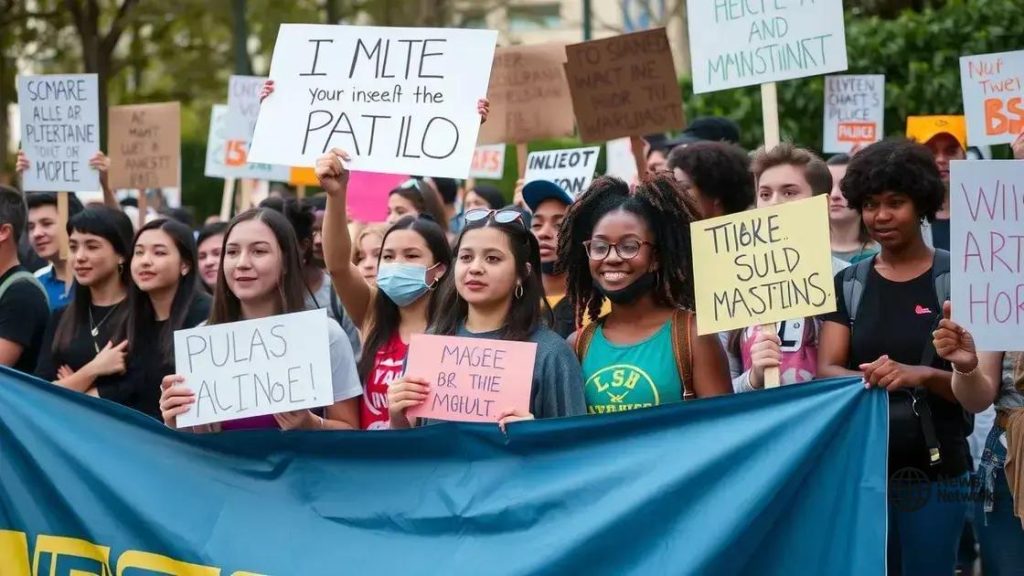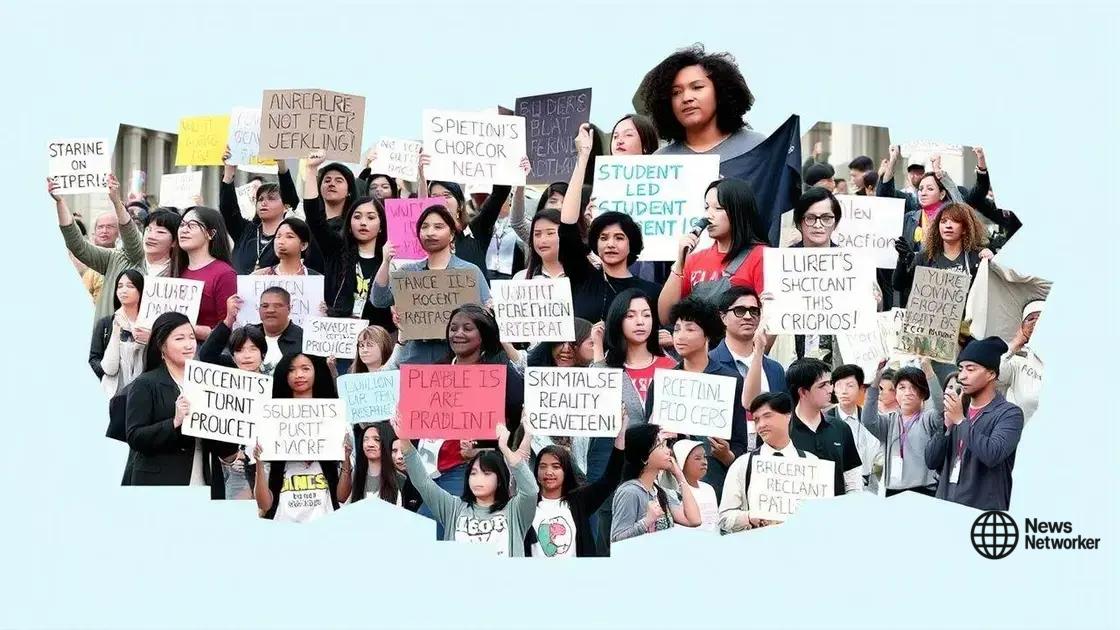Rising influence of student activism in today’s society

The rising influence of student activism is reshaping society as young people leverage social media and collaboration to address interconnected issues, driving significant social and political change.
Rising influence of student activism is gaining momentum, capturing public attention and driving social change. Have you noticed how students today are more vocal about their beliefs? Let’s explore what’s happening.
Understanding the roots of student activism
Understanding the roots of student activism provides insight into how young voices are shaping the future. Historically, students have been at the forefront of social and political movements, advocating for change.
Student activism often emerges from a combination of personal experiences and broader societal issues. Many students find themselves passionate about causes like climate change, racial equality, and education reform. As they encounter challenges in their communities, they are motivated to take action.
Key Historical Events
Several pivotal moments have fueled student activism over the decades. Events like the Vietnam War protests and the Civil Rights Movement showcased the power of young people standing up for their beliefs. These moments continue to inspire current generations.
Factors Influencing Student Activism
- Education: Students educated about social justice are more likely to engage in activism.
- Technology: The rise of social media allows students to organize and share their messages quickly.
- Community Issues: Local problems often ignite a passion for change, pushing students to act.
As today’s students navigate their world, they are increasingly aware of the issues at play. Their activism is not only about immediate concerns but also about setting the stage for a better future. From online campaigns to on-the-ground efforts, they are using various platforms to make their voices heard.
The role of social media in mobilizing students
The role of social media in mobilizing students is significant. Today, platforms like Instagram, Twitter, and TikTok serve as powerful tools for activism. Students can spread awareness quickly and gather support for different causes. By using social media, they connect with peers and amplify their voices.
Social media allows students to share their stories and experiences, making issues personal. This connection is vital for rallying others to join their movements. When students see their friends advocating for a cause, they are often inspired to participate as well.
How Social Media Mobilizes Students
- Instant Communication: Social media enables real-time sharing of information.
- Wider Reach: Posts can reach thousands, turning local issues into larger conversations.
- Engagement: Students interact through likes, shares, and comments, fostering community support.
Moreover, platforms encourage creative expression. Students create impactful visuals and videos that resonate with their audience. These creative elements can attract attention and help messages go viral. The emotional appeal of a well-crafted post can rally support in a matter of hours.
Campaigns often leverage hashtags to unite voices around a cause. This digital solidarity builds a sense of community among students who may not know each other personally but share common beliefs. The hashtag becomes a rallying cry, mobilizing a wave of activism that transcends geographical boundaries.
Case studies of successful student-led movements

Case studies of successful student-led movements showcase the power of youth activism in addressing social issues. These movements demonstrate how students can effect real change in their communities and beyond. They often start small but can grow significantly with dedication and collaboration.
One notable example is the March for Our Lives campaign. Following the tragic school shooting in Parkland, Florida, students organized nationwide protests advocating for gun control. Using social media, they mobilized fellow students and supporters from all over the country. The movement not only raised awareness but also influenced legislation, proving the strength of student voices.
Notable Student-Led Movements
- Fridays for Future: This global movement was initiated by Greta Thunberg, encouraging students to strike for climate action.
- Black Lives Matter: Students have played crucial roles in organizing protests demanding racial justice and police reform.
- The Chilean Student Movement: This group fought for education reform, leading to significant changes in the Chilean education system.
These movements show that when students unite, they can tackle even the toughest challenges. They often inspire one another through passionate speeches and creative campaigns. The use of social media amplifies their reach, allowing their messages to travel far and wide.
Furthermore, successful movements tend to highlight accessibility and inclusivity. They often encourage students from diverse backgrounds to participate, ensuring that a wide range of voices is heard. This diversity strengthens the movement and addresses a broader spectrum of issues.
Challenges faced by young activists
Challenges faced by young activists reveal the complexities of their efforts to drive change. These challenges can be significant, as they navigate both societal expectations and their desire to make a difference. Understanding these obstacles helps highlight the resilience of these young individuals.
Young activists often deal with lack of resources. Without funding or support, it can be tough to organize events or campaigns. Many rely on personal finances or small donations, which limits their outreach abilities. This can lead to frustration and burnout, making it hard to maintain momentum.
Social and Political Obstacles
Additionally, the political climate can pose a significant challenge. Activists may face pushback from officials or institutions resistant to change. This resistance can come in many forms, including legal barriers or misinformation. Young activists often have to work harder to prove their ideas, facing skepticism about their passion and awareness of the issues at stake.
- Age Discrimination: Many people may dismiss young voices simply because of their age, underestimating their capabilities.
- Safety Concerns: Protests and demonstrations can sometimes turn dangerous, putting activists at risk of harm.
- Isolation: Young activists might feel alone in their efforts, lacking a supportive network to encourage them.
Moreover, managing personal life with activism can be overwhelming. Students juggle school, work, and social lives alongside their dedication to activism. This balancing act requires immense time management skills and can lead to stress and anxiety.
Despite these challenges, many young activists continue to push forward. Their passion often drives them to find innovative solutions to overcome obstacles. Being resourceful and adaptable is vital for survival in the ever-changing landscape of activism.
Future trends in student activism
Future trends in student activism suggest that young activists will become even more influential in shaping social change. As technology and society evolve, so too do the methods that students use to advocate for their causes. These trends point to a more connected and informed generation.
One emerging trend is the use of digital platforms for organizing protests and raising awareness. Social media channels like TikTok, Instagram, and Twitter are expected to play a larger role in activism. These platforms allow students to share their messages creatively and reach wider audiences faster than ever before.
The Rise of Intersectionality
Another trend is the increasing focus on intersectionality. Students today understand that social issues are interconnected. They often advocate for multiple causes at once, like climate justice, racial equality, and mental health, recognizing how they overlap. This holistic approach strengthens movements and creates a united front in activism.
- Collaborative Efforts: Students are likely to partner with various organizations to amplify their messages.
- Global Movements: Activism will continue to cross borders, with students supporting causes worldwide.
- Innovative Campaigns: Expect new methods and campaigns that combine art, technology, and activism.
Moreover, activism will likely see a shift towards sustainability. Young people are becoming more aware of the environmental impact of their actions and are seeking to make lasting changes that protect our planet. This focus on sustainability may change the way campaigns are organized and executed.
As we look to the future, the potential for student-led initiatives to effect change is bright. With their passion, resourcefulness, and ability to adapt to new tools and ideas, students will surely continue to challenge the status quo and push for a better world.
In conclusion, the landscape of student activism is constantly evolving. As young people become more aware of the world around them, they are using their voices to create impactful change. With the aid of social media, they can connect with others and raise awareness quickly. The future looks promising, with a focus on sustainability and intersectionality guiding their efforts. Despite facing challenges, student activists are determined to overcome obstacles and drive meaningful progress. Their passion, creativity, and resilience will undoubtedly shape the future of social movements.
FAQ – Frequently Asked Questions about Student Activism
How do social media platforms impact student activism?
Social media allows students to share their messages quickly, connect with others, and organize events on a larger scale.
What role does intersectionality play in student movements?
Intersectionality helps students understand how different social issues are connected, allowing for a broader approach to activism.
What challenges do young activists typically face?
Young activists often encounter lack of resources, political resistance, and social stigma regarding their age.
How can students ensure their movements are sustainable?
By focusing on environmental impact and collaborating with other organizations, students can create long-lasting changes.





